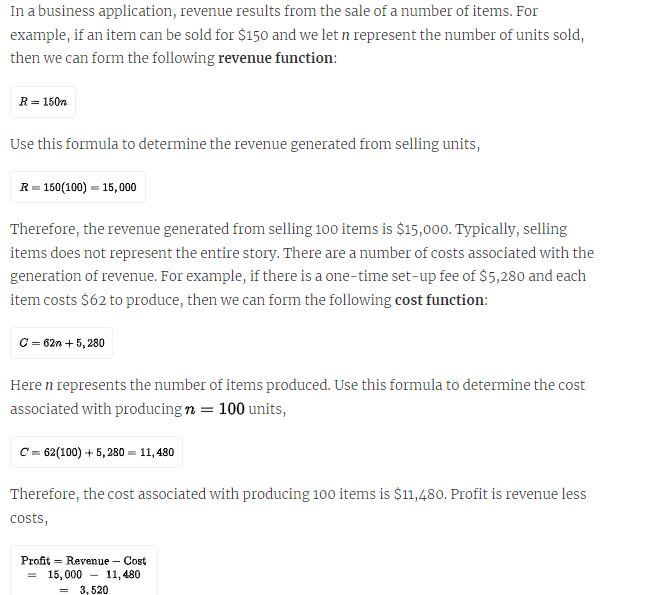Here n represents the number of items produced. Use this formula to determine the cost associated with producing n = 100 units, C = 62(100) + 5,280 = 11,480 Therefore, the cost associated with producing 100 items is $11,480. Profit is revenue less costs, Profit Revenue - Cost = 15,000- 11,480 = 3.520
Here n represents the number of items produced. Use this formula to determine the cost associated with producing n = 100 units, C = 62(100) + 5,280 = 11,480 Therefore, the cost associated with producing 100 items is $11,480. Profit is revenue less costs, Profit Revenue - Cost = 15,000- 11,480 = 3.520
Advanced Engineering Mathematics
10th Edition
ISBN:9780470458365
Author:Erwin Kreyszig
Publisher:Erwin Kreyszig
Chapter2: Second-order Linear Odes
Section: Chapter Questions
Problem 1RQ
Related questions
Question

Transcribed Image Text:This equation shows that the profit generated by producing and selling 100 items is
$3,520. In general, given a revenue formulaR and a cost formula, Owe can form a profit
function by subtracting as follows:
P-R-C
Example: The cost in dollars of producing n items is given by the formula
C = 62n +5280. The revenue in dollars is given by R = 150n where n represents the
number items sold. Write a formula that gives the profit generated by producing and
selling n items. Use the formula to determine how many items must be produced and sold
to earn at least $7,000 in profit.
Solution: Obtain the profit function by subtracting the cost function from the revenue
function.
PR-C
= 150m (62n +5,280)
= 150n62n-5, 280
= 88n-5, 280
Therefore, P = 88n - 5, 280 models the profit. To determine the number of items that
must be produced and sold to profit at least $7,000 solve the following:
P27,000
885, 2807,000
887212, 280
n2 139.5
Round up because the number of units produced and sold must be an integer. To see this,
calculate the profit when n is 139 and 140 units.
P = 88(139)-5, 280 = 6,952
P = 88 (140) -5,280 = 7, 040
Answer: 140 or more items must be produced and sold to profit at least $7,000.
Sometimes the costs exceed the revenue, in which case, the profit will be negative. For

Transcribed Image Text:In a business application, revenue results from the sale of a number of items. For
example, if an item can be sold for $150 and we let n represent the number of units sold,
then we can form the following revenue function:
R = 150m
Use this formula to determine the revenue generated from selling units,
R = 150(100) = 15,000
Therefore, the revenue generated from selling 100 items is $15,000. Typically, selling
items does not represent the entire story. There are a number of costs associated with the
generation of revenue. For example, if there is a one-time set-up fee of $5,280 and each
item costs $62 to produce, then we can form the following cost function:
C = 62n +5,280
Here n represents the number of items produced. Use this formula to determine the cost
associated with producing n = 100 units,
C = 62(100) + 5,280 = 11,480
Therefore, the cost associated with producing 100 items is $11,480. Profit is revenue less
costs,
Profit Revenue - Cost
= 15,000
11, 480
= 3,520
Expert Solution
Step 1

Step by step
Solved in 2 steps with 2 images

Recommended textbooks for you

Advanced Engineering Mathematics
Advanced Math
ISBN:
9780470458365
Author:
Erwin Kreyszig
Publisher:
Wiley, John & Sons, Incorporated

Numerical Methods for Engineers
Advanced Math
ISBN:
9780073397924
Author:
Steven C. Chapra Dr., Raymond P. Canale
Publisher:
McGraw-Hill Education

Introductory Mathematics for Engineering Applicat…
Advanced Math
ISBN:
9781118141809
Author:
Nathan Klingbeil
Publisher:
WILEY

Advanced Engineering Mathematics
Advanced Math
ISBN:
9780470458365
Author:
Erwin Kreyszig
Publisher:
Wiley, John & Sons, Incorporated

Numerical Methods for Engineers
Advanced Math
ISBN:
9780073397924
Author:
Steven C. Chapra Dr., Raymond P. Canale
Publisher:
McGraw-Hill Education

Introductory Mathematics for Engineering Applicat…
Advanced Math
ISBN:
9781118141809
Author:
Nathan Klingbeil
Publisher:
WILEY

Mathematics For Machine Technology
Advanced Math
ISBN:
9781337798310
Author:
Peterson, John.
Publisher:
Cengage Learning,

